新概念英语一册教学大纲
【英语】1新概念教学大纲

【关键字】英语
《新概念英语第一册教学大纲》
一、本门课程介绍
新概念英语第一册是英语学习者的入门课程,是练好英语基本功最好的学习书籍。
从基本的发音、重音和语调开始,逐步学会使用英语中的基本词汇、语法及句型结构,为学生进一步学习打下牢固的根底。
学好第一册,是练好英语基本功的关键,掌握了第一册,才真正踏进了英语之门。
适合于零起点或英语根底差,欲在短期内掌握英语根底的学习者,如中学生或及成年初学者,同时也可以帮助学生进一步巩固所学的知识。
第一册大部分的场景对话和口语基本句型都包括其中,同时,当中的800个词汇全部是英语日常用语中出现频率最高的词汇。
二、课程目标
1、掌握教材所涉及的英语语音、语调、根底语法、词法和句法达到初中一年级的英语水平
2、对英语形成基本的语感,熟悉标准的英语发音系统,拥有简单的英语听力能力
3、能进行简单的日常对话,掌握近两百个口语常用句型,掌握近千个日常会话所需单词
4、掌握包括现在进行时等在内的所有英语基本时态,能进行简单阅读和写作
5、掌握高频词汇800~1500
三、教学重点
帮助学生建立学习英语的自信,找到正确的、适合自己的学习方法。
在学习的过程中掌握课程中出现的常用短语,日常会话,一般习惯用法等。
并养成多听多说的学习习惯,培养英语思维。
四、教学规划
此文档是由网络收集并进行重新排版整理.word可编辑版本!。
新概念一册1-36课教材大纲

语法:
1.继续学习掌握规则名词单数变复数规律。-fe,-f结尾;o结尾
2.个别不规则名词单复数形式。Man, woman, policeman…
重点: What are their jobs?
难点:名词复数的变化
情感态度
1.培养学生积极主动地参与课堂活动,大胆开口、主动模仿。
情感态度
1.培养学生积极主动地参与课堂活动,大胆开口、主动模仿。
2.老师帮助学生复习前阶段知识。
学习策略
1.能够在学习和课堂活动中集中注意力15-20分钟。
2.本课复习性质较大,鼓励学生用所学过的多个句型自拍自演一段短剧。
文化意识
简单介绍海关的作用,以及出国旅游申办护照的过程。
教学目标
新概念一册
授课内容
Here you are. Here it is.递给别人东西时常用此句。(三会)
语法:
1.初步掌握名词所有格形式,即名词后加’s
2.初步了解并使用名词性物主代词his, hers
重点: Whose is this/that shirt? It’s …’s用于询问某物的归属。
难点:名词所有格形式,即名词后加’s
语法:
1.不定冠词a/ an的用法(四会)
2.is与He she it的搭配使用(四会)
3.由is引导的选择疑问句(四会)
重点: is与He she it的搭配使用(四会)
难点:不定冠词an的用法
情感态度
1.培养学生积极主动地参与课堂活动,大胆开口、主动模仿。
2.培养学生同陌生人交流的能力,培养学生外向的性格。
难点:形容词性物主代词your his her与人称代词you he she的对比
新概念一册教学大纲

清华少儿外语新概念英语第一册大纲使用说明新概念英语堪称经典,教材中的文章语言优雅,凝练,句型工整又富于文化。
教材着重分析句子之间的内在的逻辑关系,使学习者认识到句型的精炼,优美,实用与课模仿性,从而将其有机地运用与英语的使用之中,并进一步扩充讲解词汇,短语以及语法的实战运用。
为了提高学生在培训学校的成绩,使学生在培训学校所学的知识与公立学校所学习的知识点能成功对接。
同时也方便教师能清晰明了地了解新概念英语每二课的教学重难点。
我们特此编写了本套英语学习大纲。
本套大纲共分为:教学目标(知识目标和技能目标),教学重难点,情感态度,学习策略,文化意识五个部分。
其中知识目标中的原四会单词改为五会单词,即“听”“说”“读”“写”与“用”,其中“用”要求学生在四会基础上,能对单词或者句型达到举一反三的目的;教学难点部分对课文中所涉及的的重要词法和句法进行说明阐述。
同时给出公立学校所用的教材的知识点的出处。
使二者有效地结合,更好地提高学生应试能力。
情感态度部分给出学生一些指导性的社会实践内容,意在培养学生的文化修养和知识储备。
文化意识部分有助于学生了解英文化,又能扩展相关知识。
本套大纲特点:(1)针对行强:教案式编写,知识点重难点一目了然。
(2)信息含量高:充分体现:综合,应用,创新的精神,(3)知识含量丰富:几乎每课都有相应文化信息渗透,让学生的综合能力得到提成。
(4)简明扼要:直入主题,明确知识点。
本套大纲的使用方法课前准备:翻看并查阅教学目标中的重点词汇句型,在教学中进行反复操练。
课上演示:针对大纲提到的语法和误会句型,加大检测训练,使学生真正地做到学以致用。
课中教授:在传授支持的同时,讲一些文化知识和人生哲理。
寓教于乐。
课后回顾:针对大纲的知识点,教授出一些相关练习题,达到巩固的目的。
二、教学大纲。
《新概念1》课程实施性教学大纲.doc
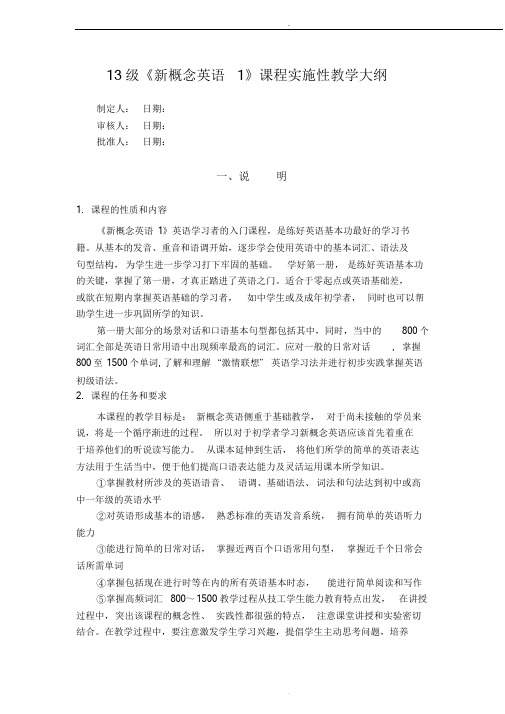
13 级《新概念英语1》课程实施性教学大纲制定人:日期:审核人:日期:批准人:日期:一、说明1. 课程的性质和内容《新概念英语1》英语学习者的入门课程,是练好英语基本功最好的学习书籍。
从基本的发音、重音和语调开始,逐步学会使用英语中的基本词汇、语法及句型结构,为学生进一步学习打下牢固的基础。
学好第一册,是练好英语基本功的关键,掌握了第一册,才真正踏进了英语之门。
适合于零起点或英语基础差,或欲在短期内掌握英语基础的学习者,如中学生或及成年初学者,同时也可以帮助学生进一步巩固所学的知识。
第一册大部分的场景对话和口语基本句型都包括其中,同时,当中的800个词汇全部是英语日常用语中出现频率最高的词汇。
应对一般的日常对话, 掌握800至1500个单词, 了解和理解“激情联想”英语学习法并进行初步实践掌握英语初级语法。
2. 课程的任务和要求本课程的教学目标是:新概念英语侧重于基础教学,对于尚未接触的学员来说,将是一个循序渐进的过程。
所以对于初学者学习新概念英语应该首先着重在于培养他们的听说读写能力。
从课本延伸到生活,将他们所学的简单的英语表达方法用于生活当中,便于他们提高口语表达能力及灵活运用课本所学知识。
①掌握教材所涉及的英语语音、语调、基础语法、词法和句法达到初中或高中一年级的英语水平②对英语形成基本的语感,熟悉标准的英语发音系统,拥有简单的英语听力能力③能进行简单的日常对话,掌握近两百个口语常用句型,掌握近千个日常会话所需单词④掌握包括现在进行时等在内的所有英语基本时态,能进行简单阅读和写作⑤掌握高频词汇800~1500教学过程从技工学生能力教育特点出发,在讲授过程中,突出该课程的概念性、实践性都很强的特点,注意课堂讲授和实验密切结合。
在教学过程中,要注意激发学生学习兴趣,提倡学生主动思考问题,培养学生的自学能力。
《新概念英语》教学中教师要加强对于学生背诵方面的训练。
在学习过程中,背诵一些经典课文将对英语的记忆、理解非常有益。
新概念英语第一册教学大纲及教学安排

新概念英语第一册教学大纲及教学安排教学大纲课程介绍本教材是为初学者设计的英语教程,旨在帮助学生掌握基础的英语听、说、读、写技能。
通过本教材的研究,学生将逐渐建立起对英语语言的基本理解和运用能力。
课程目标1. 培养学生对英语的兴趣和研究动力。
2. 培养学生的听说能力,使其能够进行简单的日常交流。
3. 培养学生的阅读理解能力,使其能够读懂简单的英语文章。
4. 培养学生的写作能力,使其能够用简单的英语表达自己的意思。
课程安排单元1: 欢迎- 研究目标:研究如何问候和自我介绍。
- 研究重点:问候语、自我介绍。
- 教学活动:角色扮演、听力练、口语练。
单元2: 饮食- 研究目标:研究一些基本的饮食词汇和表达方式。
- 研究重点:食物、饮料、点菜。
- 教学活动:词汇练、看图说话、模拟情景对话。
单元3: 家庭- 研究目标:研究描述家庭成员和家庭活动的词汇和句型。
- 研究重点:家庭成员、家庭活动、时间表达。
- 教学活动:听力理解练、口语练、写作练。
单元4: 时间- 研究目标:研究如何表达时间和描述日常活动。
- 研究重点:时间表达、日常活动、一般现在时。
- 教学活动:听力练、口语练、阅读练。
单元5: 学校- 研究目标:研究描述学校和学生生活的词汇和句型。
- 研究重点:学校设施、研究科目、日程安排。
- 教学活动:角色扮演、听力理解、口语练。
...(继续列出其他单元的教学安排)总结本教学大纲旨在帮助学生初步掌握英语的基础知识和交流能力。
通过有趣而实用的教学活动,学生可以在轻松的学习氛围中提高听说读写的能力。
希望学生们在本课程中取得令人满意的进步,并对学习英语保持持久的兴趣和热情。
新概念英语第一册教学大纲

新概念英语第一册教学大纲XXX Curriculum for Grade One XXXTextbook: New Concept English Book OneClass le: Three classes per week。
with each unit consisting of two lessons。
totaling 1.5 hours.I。
Course Objectives:1.Master the English n。
n。
basic grammar。
vocabulary。
and syntax XXX。
achieving the level of English in the first year of r or r high school.2.Develop a basic sense of English。
familiarize oneself with the standard English n system。
XXX.3.Be able to engage in simple daily ns。
master nearly 200 XXX。
and acquire nearly 1,000 words XXX.4.Master all basic English tenses。
including the present continuous tense。
and be able to engage in simple reading and writing.5.Master high-frequency vocabulary ranging from 800 to 1500.II。
Class Arrangement:There are 144 classes in total。
with each unit consisting of either one or two lessons。
新概念英语一册教学大纲

新概念英语第一册教学大纲一、知识要点上半部分(第1~72课)1.音标:2.字母:3.词汇:掌握550个基本词汇(包括称谓、日常用品、食物、颜色、疾病、国家、国籍、天气、季节、月份、星期等)。
4.简单句的六种基本句型:①主语(Subject)+谓语(vi)如:Peterworksveryhard.②主语(Subject)+系动词(Link.V)+表语(Predicate)如:Thequestionsaretoodifficult.③主语(Subject)+谓语(vt)+宾语(Object)如:Weusuallyreadnewspaperinthelivingroom.④主语(Subject)+谓语(vt)+间接宾语(OI)+直接宾语(OD)或:主语(Subject)+谓语(vt)+直接宾语(OD)+to/for+间接宾语(OI)如:Isenthimapresent.Isentapresenttohim.⑤主语(Subject)+谓语(vt)+宾语(Object)+补语(Complement)如:Youshouldkeeptheroomcleanandtidy.⑥T herebe+主语(Subject)+其它如:Thereisavaseonthetablenearthewindow.5.时态:①一般现在时:⑴概念:表示经常、反复发生的动作或行为及现在的某种状况。
⑵常与often,sometimes,always,usually等频率副词连用,还与everymorning/day/week,onWednesday,inthemorning/afternoon/evening等时间状语连用。
⑶基本结构:动词原形(如主语为第三人称单数,动词要加s或es)⑷否定形式:am/is/are+not;若谓语动词为行为动词,则在其前加don't,如主语为第三人称单数,则用doesn't,同时还原行为动词。
新概念英语第一册教学大纲与教学计划

新概念英语第一册教学大纲与教学计划教学大纲课程目标- 帮助学生掌握基本的英语单词和语法结构- 培养学生的听力、口语、阅读和写作能力- 提高学生的英语交流能力和文化素养教学内容和安排1. 单词和词汇- 研究常见的英语单词和词汇- 掌握它们的发音和拼写- 运用单词和词汇进行简单的对话练2. 语法- 研究基本的英语语法规则- 理解句子的结构和构成- 运用语法进行句子的构造和转换3. 阅读理解- 练阅读简短的英语文章和句子- 理解文章的主旨和细节- 回答相关问题以加强理解能力4. 听力训练- 听取英语短语和句子- 理解并提取关键信息- 回答相关问题以检验听力水平5. 口语表达- 练日常生活中常用的英语口语表达- 进行简单的对话和交流- 提高口语流利度和表达能力教学方法和策略- 结合听说读写四个方面进行综合训练- 使用教材上的例句和练题进行实践- 利用多媒体和互动教学工具增强教学效果- 提供合适的角色扮演和群体活动,激发学生参与积极性- 给予学生充分的练机会和反馈意见教学计划课程时长和安排- 总课时: 60学时- 每周课时: 2学时- 教学周期: 30周每课时内容和目标1. 课时1-2:- 研究英语的基本字母表和发音规则- 掌握一些简单的日常用语和问候语2. 课时3-4:- 研究常用名词和动词,并掌握其基本用法- 进行简单的句子构造练3. 课时5-6:- 研究形容词和副词,并掌握其基本用法- 运用形容词和副词进行句子扩展和修饰4. 课时7-8:- 研究基本的语法规则,如肯定句、否定句和疑问句的构成- 进行相关的句子转换练5. 课时9-10:- 阅读简短的英语文章,理解其主要内容和细节- 回答相关问题以提高阅读理解能力6. 课时11-12:- 听取简短的英语对话和句子- 理解并提取关键信息,回答相关问题7. 课时13-14:- 练日常生活中常用的英语口语表达- 进行简单的对话和交流练8. 课时15-16:- 复和巩固之前学过的内容- 进行综合练和检测测试和评估- 每学期结课前进行一次考试,测试学生的听说读写能力- 平时通过课堂练、作业和参与度评估学生的研究进展。
新概念第一册教案全册完整版

新概念第一册教案全册完整版一、教学内容1. Chapter 1: Excuse me!(对不起!)介绍日常用语,如问候、道歉、道别等。
基本语法:一般疑问句、否定句、一般现在时。
2. Chapter 2: Is this your?(这是你的吗?)学习如何描述物品和人物。
基本语法:一般现在时、一般疑问句、否定句。
3. Chapter 3: Thank you, madam.(谢谢,夫人。
)学习购物场景的日常用语。
基本语法:一般现在时、一般疑问句、否定句。
4. Chapter 4: What's the time?(现在几点?)学习时间表达法。
基本语法:一般现在时、一般疑问句、否定句。
5. Chapter 5: The Sawyer family.(索耶尔一家。
)学习家庭成员的称呼。
基本语法:一般现在时、一般疑问句、否定句。
二、教学目标1. 让学生掌握基本的日常英语用语,提高英语口语表达能力。
2. 使学生熟练运用一般现在时,形成正确的语法观念。
3. 培养学生用英语进行简单交流的能力。
三、教学难点与重点1. 教学难点:一般现在时、一般疑问句、否定句的运用。
2. 教学重点:日常英语用语的掌握。
四、教具与学具准备1. 教具:PPT、黑板、磁带、录音机。
2. 学具:教材、练习册、笔记本。
五、教学过程1. 导入:通过情景剧表演,让学生复习上一课的内容。
2. 新课内容:讲解本章重点单词、短语和句型。
3. 例题讲解:通过例题讲解,让学生理解语法点。
4. 随堂练习:让学生进行口头练习,巩固所学知识。
5. 小组活动:分组讨论,练习本章重点句型。
六、板书设计1. 重点单词、短语。
2. 重点句型。
七、作业设计1. 作业题目:(1)抄写本章重点单词、短语。
(2)用本章所学句型编写一段对话。
(3)完成练习册本章练习。
答案:见练习册答案。
八、课后反思及拓展延伸1. 反思:关注学生在课堂上的表现,及时发现问题,调整教学方法。
新概念英语第一册教学大纲及教学内容

新概念英语第一册教学大纲及教学内容
教学大纲
- 课程目标:帮助学生掌握基本的英语听、说、读、写技能,
打下英语研究的基础。
- 课程时长:共30个课时,每个课时45分钟。
- 教学方法:综合运用听说读写的教学方法,注重口语表达和
语言应用能力的培养。
- 教学材料:《新概念英语第一册》教材、课本配套的录音材料。
教学内容
1. Unit 1-10:介绍英语的基本发音规则、字母表、问候语等,
培养学生的听力和口语交际能力。
2. Unit 11-20:研究英语的基本语法知识,如肯定句、否定句、疑问句等,提升学生的语法应用能力。
3. Unit 21-30:研究更复杂的语法结构,如比较级、最高级、
时态等,进一步巩固语法知识并提高学生的语言运用能力。
4. 阅读理解:通过阅读短文和练题,培养学生对英语文章的阅
读理解能力。
5. 写作训练:通过书面作文的练,提升学生的英语书写能力和
表达能力。
教学评估
1. 课堂表现:根据学生的听力、口语、阅读、写作表现进行评估,并及时给予反馈。
2. 课后作业:布置相关的作业,检验学生对教学内容的理解和
掌握情况。
3. 测试评估:定期进行测试,评估学生在听说读写方面的综合
能力。
教学资源
1. 教学录音:提供课本配套的录音材料,供学生进行听力训练。
2. 辅助教材:提供相关的练册、词汇表等辅助教材,帮助学生
巩固和扩展所学知识。
以上为新概念英语第一册的教学大纲及教学内容概述。
希望通
过系统的研究和训练,学生能够掌握基本的英语语言能力,并为进
一步研究打下坚实的基础。
新概念英语教学大纲

《新概念英语》教学大纲一、课程名称:新概念英语课程类型:专业基础课程学分:16 总学时:288 理论学时:288 实验学时:0先修课程:新概念英语适用专业: 商务英语二、课程性质、目的和任务《新概念英语》第一册是练好英语基本功最好的学习书籍。
从基本的发音、重音和语调开始,逐步学会使用英语中的基本词汇、语法及句型结构。
是练好英语基本功的关键。
适合于中技三年制商务英语专业学生,帮助学生进一步巩固所学的知识。
大部分的场景对话和口语基本句型都包括其中,同时,当中的800个词汇全部是英语日常用语中出现频率最高的词汇。
应对一般的日常对话, 掌握800至1500个单词,了解和理解“激情联想”英语学习法并进行初步实践掌握英语初级语法、知识、能力、素质的基本要求;《新概念英语》第二册是学习英语的基础阶段,全书共有96课,每篇课文以150个单词左右的小故事组成。
课文故事性强,易于学习。
每篇课文重点、语法知识点各异,但全册课文前后连贯,语法知识全面,形成了新概念特有的英语语法体系。
学习分析句子结构,提高阅读理解能力,活学活用英语中级语法,掌握1500至4000个单词.三、教学的基本要求1、知识、能力、素质的基本要求;通过本门课程的学习要求学生学习分析句子结构,提高阅读理解能力,活学活用英语中级语法,掌握1500至4000个单词.2、教学模式基本要求(课程主要教学环节要求,教学方法及手段要求);为使学生熟练掌握新概念英语的基本知识点,本课程采用教师讲授与学生讨论、演示相结合,并辅以多媒体、板书、幻灯等教学工具。
3、考核方法基本要求。
考核采用百分制,“综合成绩”由“平时成绩”、“期中考试成绩”和“期末考试成绩”组成。
其中,“平时成绩”占20%,“期中考试成绩”占20%,“期末考试成绩”占60%。
“平时成绩”通过作业成绩、课上配合表现、出勤率及课堂纪律的考核确定。
迟到、早退、旷课均予以扣分。
缺勤超过三分之一,或作业未完成次数超过三分之一,取消考试资格。
新概念一册教学大纲
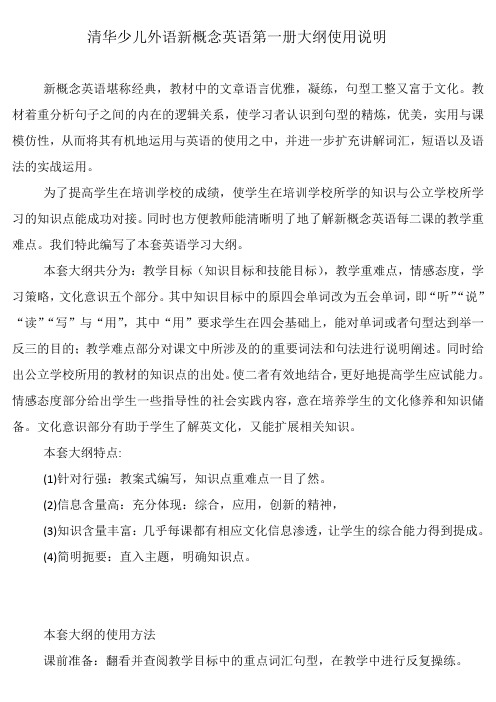
清华少儿外语新概念英语第一册大纲使用说明新概念英语堪称经典,教材中的文章语言优雅,凝练,句型工整又富于文化。
教材着重分析句子之间的内在的逻辑关系,使学习者认识到句型的精炼,优美,实用与课模仿性,从而将其有机地运用与英语的使用之中,并进一步扩充讲解词汇,短语以及语法的实战运用。
为了提高学生在培训学校的成绩,使学生在培训学校所学的知识与公立学校所学习的知识点能成功对接。
同时也方便教师能清晰明了地了解新概念英语每二课的教学重难点。
我们特此编写了本套英语学习大纲。
本套大纲共分为:教学目标(知识目标和技能目标),教学重难点,情感态度,学习策略,文化意识五个部分。
其中知识目标中的原四会单词改为五会单词,即“听”“说”“读”“写”与“用”,其中“用”要求学生在四会基础上,能对单词或者句型达到举一反三的目的;教学难点部分对课文中所涉及的的重要词法和句法进行说明阐述。
同时给出公立学校所用的教材的知识点的出处。
使二者有效地结合,更好地提高学生应试能力。
情感态度部分给出学生一些指导性的社会实践内容,意在培养学生的文化修养和知识储备。
文化意识部分有助于学生了解英文化,又能扩展相关知识。
本套大纲特点:(1)针对行强:教案式编写,知识点重难点一目了然。
(2)信息含量高:充分体现:综合,应用,创新的精神,(3)知识含量丰富:几乎每课都有相应文化信息渗透,让学生的综合能力得到提成。
(4)简明扼要:直入主题,明确知识点。
本套大纲的使用方法课前准备:翻看并查阅教学目标中的重点词汇句型,在教学中进行反复操练。
课上演示:针对大纲提到的语法和误会句型,加大检测训练,使学生真正地做到学以致用。
课中教授:在传授支持的同时,讲一些文化知识和人生哲理。
寓教于乐。
课后回顾:针对大纲的知识点,教授出一些相关练习题,达到巩固的目的。
二、教学大纲。
1新概念教学大纲

本级别共 144 课,其中单课为课文,双课为语法和练习,整本书是以单数课为 正课。共 72 个教学单元,每个教学单元可以安排 1—1.5 个课时,每个课时 50 分钟。
四、教学重点
帮助学生建立学习英语的自信,找到正确的、适合自己的学习方法。在学习的 过程中掌握课程中出现的常用短语,日常会话,一般习惯用法等。并养成多听多说 的学习习惯,培养英语思维。
《新概念英语第一册教学大纲》
(两部分 144 课,72 个教学单元,72-108 课时)
一、本门课程介绍
新概念英语第一册是英语学习者的入门课程,是练好英语基本功最好的学习书籍。 从基本的发音、重音和语调开始,逐步学会使用英语中的基本词汇、语法及句型结构, 为学生进一步学习打下牢固的基础。学好第一册,是练好英语基本功的关键,掌握了 第一册,才真正踏进了英语之门。适合于零起点或英语基础差,欲在短期内掌握英语 基础的学习者,如中学生或及成年初学者,同时也可以帮助学生进一步巩固所学的知 识。
对全部高中资料试卷电气设备,在安装过程中以及安装结束后进行高中资料试卷调整试验;通电检查所有设备高中资料电试力卷保相护互装作置用调与试相技互术关,通系电1,力过根保管据护线生高0不产中仅工资2艺料22高试2可中卷以资配解料置决试技吊卷术顶要是层求指配,机置对组不电在规气进范设行高备继中进电资行保料空护试载高卷与中问带资题负料2荷试2,下卷而高总且中体可资配保料置障试时2卷,32调需3各控要类试在管验最路;大习对限题设度到备内位进来。行确在调保管整机路使组敷其高设在中过正资程常料1工试中况卷,下安要与全加过,强度并看工且25作尽52下可22都能护可地1关以缩于正小管常故路工障高作高中;中资对资料于料试继试卷电卷连保破接护坏管进范口行围处整,理核或高对者中定对资值某料,些试审异卷核常弯与高扁校中度对资固图料定纸试盒,卷位编工置写况.复进保杂行护设自层备动防与处腐装理跨置,接高尤地中其线资要弯料避曲试免半卷错径调误标试高方中等案资,,料要编试求5写、卷技重电保术要气护交设设装底备备置。4高调、动管中试电作线资高气,敷料中课并设3试资件且、技卷料中拒管术试试调绝路中验卷试动敷包方技作设含案术,技线以来术槽及避、系免管统不架启必等动要多方高项案中方;资式对料,整试为套卷解启突决动然高过停中程机语中。文高因电中此气资,课料电件试力中卷高管电中壁气资薄设料、备试接进卷口行保不调护严试装等工置问作调题并试,且技合进术理行,利过要用关求管运电线行力敷高保设中护技资装术料置。试做线卷到缆技准敷术确设指灵原导活则。。:对对在于于分调差线试动盒过保处程护,中装当高置不中高同资中电料资压试料回卷试路技卷交术调叉问试时题技,,术应作是采为指用调发金试电属人机隔员一板,变进需压行要器隔在组开事在处前发理掌生;握内同图部一纸故线资障槽料时内、,设需强备要电制进回造行路厂外须家部同出电时具源切高高断中中习资资题料料电试试源卷卷,试切线验除缆报从敷告而设与采完相用毕关高,技中要术资进资料行料试检,卷查并主和且要检了保测解护处现装理场置。设。备高中资料试卷布置情况与有关高中资料试卷电气系统接线等情况,然后根据规范与规程规定,制定设备调试高中资料试卷方案。
新概念英语教学大纲
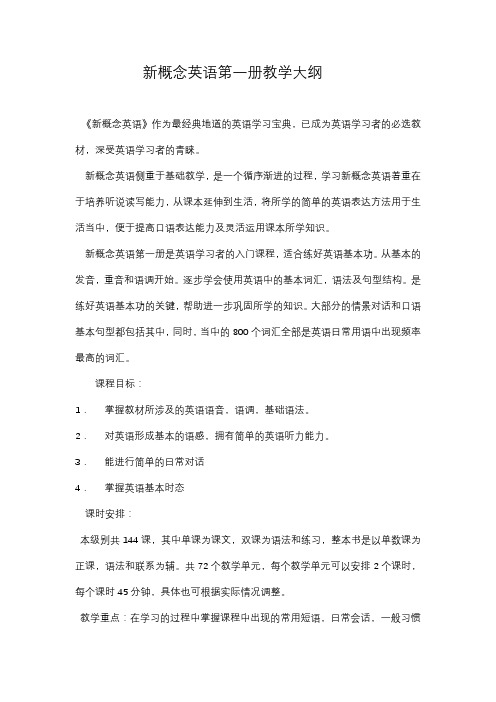
新概念英语第一册教学大纲
《新概念英语》作为最经典地道的英语学习宝典,已成为英语学习者的必选教材,深受英语学习者的青睐。
新概念英语侧重于基础教学,是一个循序渐进的过程,学习新概念英语着重在于培养听说读写能力,从课本延伸到生活,将所学的简单的英语表达方法用于生活当中,便于提高口语表达能力及灵活运用课本所学知识。
新概念英语第一册是英语学习者的入门课程,适合练好英语基本功。
从基本的发音,重音和语调开始。
逐步学会使用英语中的基本词汇,语法及句型结构。
是练好英语基本功的关键,帮助进一步巩固所学的知识。
大部分的情景对话和口语基本句型都包括其中,同时,当中的800个词汇全部是英语日常用语中出现频率最高的词汇。
课程目标:
1.掌握教材所涉及的英语语音,语调,基础语法。
2.对英语形成基本的语感,拥有简单的英语听力能力。
3.能进行简单的日常对话
4.掌握英语基本时态
课时安排:
本级别共144课,其中单课为课文,双课为语法和练习,整本书是以单数课为正课,语法和联系为辅。
共72个教学单元,每个教学单元可以安排2个课时,每个课时45分钟,具体也可根据实际情况调整。
教学重点:在学习的过程中掌握课程中出现的常用短语,日常会话,一般习惯
用法等。
教学难点:扎实英语基础知识
所需教材:《新概念英语第一册》,《新概念英语第一册教师用书》
所需仪器:投影仪,音响,手写白板
(讲义资料复印每个课时前自备)
教学人员:曲寅/陈彦。
新概念英语第一册教学大纲附有详细教学内容
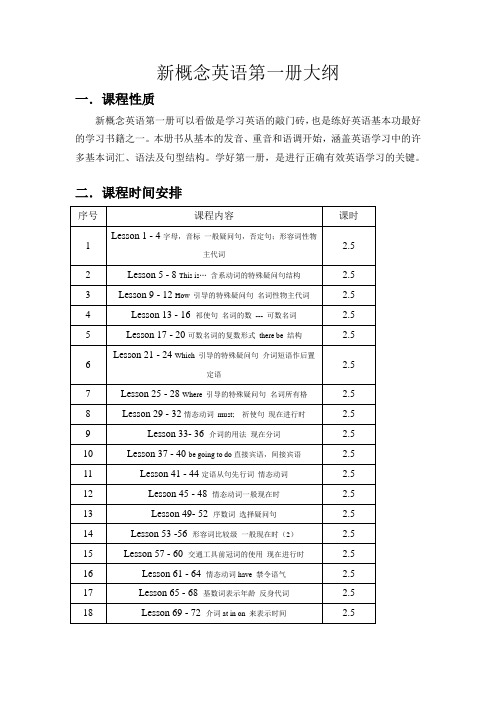
新概念英语第一册大纲一.课程性质新概念英语第一册可以看做是学习英语的敲门砖,也是练好英语基本功最好的学习书籍之一。
本册书从基本的发音、重音和语调开始,涵盖英语学习中的许多基本词汇、语法及句型结构。
学好第一册,是进行正确有效英语学习的关键。
二.课程时间安排三.课程目标1、对动词be和have的现在时和过去时会基本的应用;2、能识别和构造现在进行时;3、能识别和构成第三人称单数的一般现在时;4、能识别和构成常规的和少数非常规动词的一般过去时;5、能识别过去进行时;6、能识别简单的现在完成时和过去完成时;7、能识别和用going to, shall和will构造将来时;8、会基本应用情态动词can, may和must,能识别情态动词could, might, would。
9、能用情态动词(包括do/does, did)构造疑问句和否定句。
10、能用情态动词和疑问词开头回答疑问句;11、能用-ly, -ily构造副词,以及一些例外(如well, hard, fast);12、定冠词和不定冠词,掌握a/an, the的基本应用,以及some, any, no, much, many,a lot of与可数及不可数名词的搭配。
13、能用-s, -es, -ves构造名词,一些例外:men, women, children,teeth等;14、代词的基本应用:人称代词,物主代词,反身代词;15、形容词的基本应用:规则比较级,不规则比较级:good, bad, much,many, little;16、基本介词的应用:表示地点,时间,方向;17、关系代词:识别和应用who/whom, which, that;18、句型:This/that; these/those; There is/it is; there are/they are;19、缩写:it's, I'm, isn't, didn't等;20、描述日期、星期、季节、数量、昨天、今天、明天、时间。
新概念英语第一册教学大纲

新概念英语第一册教学大纲新概念英语第一册教学大纲随着全球化的发展,英语已经成为一门不可或缺的国际通用语言。
而对于许多英语学习者来说,掌握基本的英语语法和词汇是迈向英语学习成功的第一步。
新概念英语第一册教学大纲便是为了帮助学习者打好英语基础而设计的。
第一册的教学大纲主要包括以下几个方面内容:听力、口语、阅读、写作和语法。
通过这些不同的学习模块,学习者可以全面提高自己的英语能力。
在听力方面,第一册的教学大纲主要通过一些简单的对话和短文来训练学习者的听力技巧。
这些对话和短文通常以日常生活为主题,内容简单易懂。
通过反复听和理解这些对话和短文,学习者可以逐渐提高自己的听力水平。
口语方面,第一册的教学大纲主要注重学习者的口语表达能力。
通过模仿和练习一些简单的句子和对话,学习者可以逐渐提高自己的口语流利度和准确性。
同时,教学大纲还鼓励学习者进行口语交流,通过与他人的对话来提高自己的口语交际能力。
阅读方面,第一册的教学大纲主要通过一些简单的短文来培养学习者的阅读理解能力。
这些短文通常涉及日常生活、文化习俗等方面的内容,有助于学习者了解英语国家的文化和生活方式。
通过阅读这些短文并回答相关问题,学习者可以提高自己的阅读理解能力和词汇量。
写作方面,第一册的教学大纲主要注重学习者的写作能力。
通过一些简单的写作练习,学习者可以逐渐提高自己的写作技巧和表达能力。
这些写作练习通常包括书面表达和日记写作等,帮助学习者培养自己的写作习惯和思维能力。
最后,语法方面是第一册教学大纲的重点内容之一。
通过学习和掌握一些基本的英语语法知识,学习者可以提高自己的语法准确性和语言表达能力。
教学大纲中会涉及一些常见的语法知识点,如动词的时态、名词的单复数等,这些都是英语学习的基础。
总的来说,新概念英语第一册教学大纲是为了帮助英语学习者打好英语基础而设计的。
通过听力、口语、阅读、写作和语法等方面的综合训练,学习者可以全面提高自己的英语能力。
然而,教学大纲只是一个指导性的文件,真正的学习效果还需要学习者自己的努力和实践。
新概念一册全册大纲(普通班)
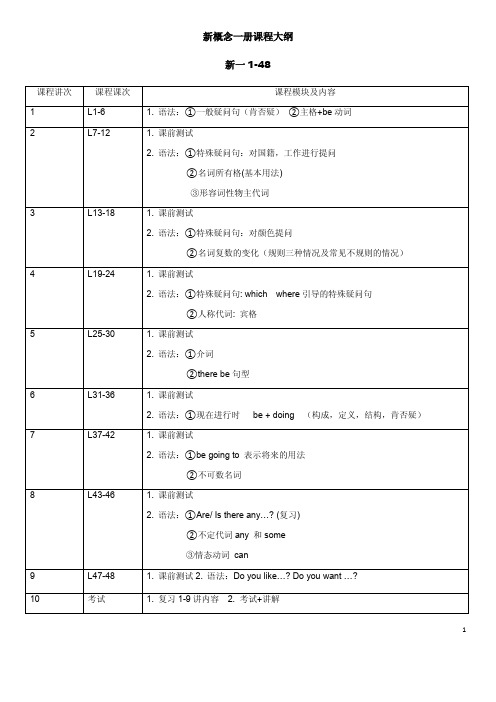
1.语法:情态动词 can,could,may,might,must&have to, had better 2. E-reading: Animals in winter1 1. 语法:被动语态:(一般现在时,一般过去时,一般将来时,现在完成时) 2. E-reading: Animals in winter2 1. 语法:①宾语从句(陈述,疑问,直引变间引) 2. E-reading:What do animals eat? 1. 语法: ①定语从句(基本用法 who,which,that) ②条件状语从句(主将从现) 2. 期末考试
2
L107&73 单词: 形容词
3
L97&115 单词: 家庭成员
1. 课前测试 2. 语法: ①代词(定义,人称代词用法及排序,物主代词,反身代词,it 三指,不定代词 ②数词(定义,分类,基数词读数和时间表达法,序数词日期表达法) 3. E-reading:My first sleepover 1
7
L69-70
语法:①时间介词 ②复习 there be 句型 期中考试
8
L71-72
1. 语法:一般过去时(动词过去式的构成&时间标志词)
9
L73-74
语法:① 副词的用法 ②复习一般过去时(动词过去式)
10
L75-78
1. 课前测试 2. 语法:① 一般过去时(时间状语) ②情态动词的否定疑问句 ③复习时间介词
2
14
L89-92
1. 语法:现在完成时(3) 2. 期末考试
15
L93-96
1. 课前测试 2. 语法:①一般将来时(时间状语,疑问句)②对时间提问 ③had better 的用法
新概念英语第一册教学大纲
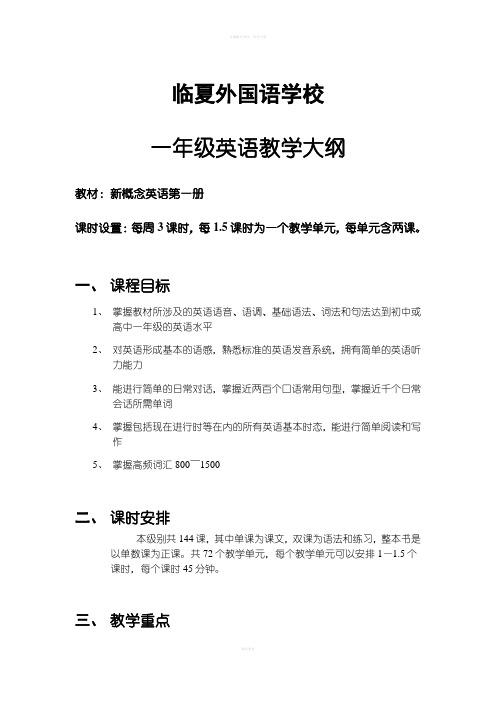
临夏外国语学校一年级英语教学大纲教材:新概念英语第一册课时设置:每周3课时,每1.5课时为一个教学单元,每单元含两课。
一、课程目标1、掌握教材所涉及的英语语音、语调、基础语法、词法和句法达到初中或高中一年级的英语水平2、对英语形成基本的语感,熟悉标准的英语发音系统,拥有简单的英语听力能力3、能进行简单的日常对话,掌握近两百个口语常用句型,掌握近千个日常会话所需单词4、掌握包括现在进行时等在内的所有英语基本时态,能进行简单阅读和写作5、掌握高频词汇800~1500二、课时安排本级别共144课,其中单课为课文,双课为语法和练习,整本书是以单数课为正课。
共72个教学单元,每个教学单元可以安排1—1.5个课时,每个课时45分钟。
三、教学重点帮助学生建立学习英语的自信,找到正确的、适合自己的学习方法。
在学习的过程中掌握课程中出现的常用短语,日常会话,一般习惯用法等。
并养成多听多说的学习习惯,培养英语思维。
四、教学难点1.纠正惯有的不准确语音,养成正确的发音习惯,培养丰富的语流,增强语感。
2.扎实英语基础知识五、教学重难点讲述方法示范教授、表演式、体验式、多媒体六、教学标准(考核标准)1.考试类型笔试(闭卷)+口试(抽题),共100分2.分数结构笔试、口试各占50%3.考试内容1)笔试考核内容包括词汇、句型、基本语法、阅读。
(题型及难易程度根据学员个体情况具体设置)2)口试①单词英汉互译②单词读音③课文背诵(抽签)④自由话题(选自课堂扩展练习内容)七、教学内容及学时分配Lesson 1 Excuse me! 对不起!Lesson 2 Is this your…这是你的…吗?1/1.5课时Lesson 3 Sorry, sir. 对不起,先生。
Lesson 4 Is this your…这是你的……吗?1/1.5课时Lesson 5 Nice to meet you 很高兴见到你Lesson 6What make is it? 它是什么牌子的?1/1.5课时Lesson 7 Are you a teacher?你是教师吗?Lesson 8 What's your job?你是做什么工作的?1/1.5课时Lesson 9 How are you today? 今天好吗?Lesson 10 Look at…看1/1.5课时Lesson 11 Is this your shirt? 这是你的衬衫吗?Lesson 12 Whose is this…?1/1.5课时Lesson 13 A new dress 一件新连衣裙Lesson 14 What colour's your…?你的……是什么颜色的?1/1.5课时Lesson 15 Your passports, please. 请出示你们的护照。
新概念教学大纲

新概念教学大纲一、教材分析新概念一册书共分为4册,分别是1A、1B、1C、1D;1A为1课到40课,1B为41到80课,1C为81到120课,1D是121课到144课,全册书共144课。
每次课讲两课(例如:L1—L2,也就是一个单元Unit1)二、课时安排每学期1A共20次课,1B-1D分别为22次课。
其中每期有3次外教课,三次外教课分别设在每5次课之后,外教课内容分别是5次课里的听说口语内容。
暑期另有5次课(10个课时),主要针对练习册、考试、练习题及未完成的课时。
三、教学目标1、全面训练学生的4项技能:理解、口语、阅读和写作。
2、对基本形成基本的语感、熟悉练习美英的发音,拥有简单的英语听力能力。
3、能进行简单的日常对话,掌握近两百个口语常用句型和近千个日常会话所需单词。
4、掌握包括现在时在内的所有英语基本时态,能进行简单的阅读和写作。
5、掌握高频词汇800到1500个。
四、教学要求单词:5个左右(三、四年级)8个左右(四、五年级)10个左右(六年级)培养音标的认知掌握及怎样拼读单词的能力。
课文提问:老师针对课文提问,孩子只做出回答,培养完整回答。
课堂培养:重视培养模仿磁带的语流、语感听和力模仿,不要求写作。
倒背图:精讲。
1B单词:不分年级,根据年龄段可写可不写,重点在单词的拼读及记忆。
课文提问:根据年龄段大小适度让孩子做出提问和完整回答。
课堂培养:重视培养模仿磁带的语流、语感听和力模仿,不要求写作。
倒背图:精讲。
1C单词:要求全背(根据单词量和孩子的程度,原则上都背),孩子已经有自己拼读单词的能力,老师要对单词进行扩展及简单的写作铺垫,课文提问:要求孩子能提问问题并能完整回答。
课堂培养:自我模仿(在家),在课堂上达到语言、语调的地道。
改写课文环节要放入课堂。
倒背图:精讲。
单词:要求全背,老师要对单词进行扩展及老师要以写作输出为主。
课文提问:要求孩子能提问问题并能流畅、熟练地完整回答。
课堂培养:自我模仿(在家),在课堂上达到语言、语调的地道。
- 1、下载文档前请自行甄别文档内容的完整性,平台不提供额外的编辑、内容补充、找答案等附加服务。
- 2、"仅部分预览"的文档,不可在线预览部分如存在完整性等问题,可反馈申请退款(可完整预览的文档不适用该条件!)。
- 3、如文档侵犯您的权益,请联系客服反馈,我们会尽快为您处理(人工客服工作时间:9:00-18:30)。
新概念英语第一册教学大纲一、知识要点上半部分(第1~72课)1.音标:2.字母:3.词汇:掌握550个基本词汇(包括称谓、日常用品、食物、颜色、疾病、国家、国籍、天气、季节、月份、星期等)。
4.简单句的六种基本句型:①主语 (Subject) +谓语 (vi)如:Peter works very hard.②主语 (Subject) +系动词 (Link. V) +表语 (Predicate)如:The questions are too difficult.③主语 (Subject) +谓语 (vt) +宾语 (Object)如:We usually read newspaper in the living room.④主语 (Subject) +谓语 (vt) +间接宾语 (OI) +直接宾语 (OD) 或:主语 (Subject) +谓语 (vt) +直接宾语 (OD) + to/for +间接宾语 (OI)如:I sent him a present. I sent a present to him.⑤主语 (Subject) +谓语 (vt) +宾语 (Object) +补语 (Complement)如:You should keep the room clean and tidy.⑥There be + 主语 (Subject) + 其它如:There is a vase on the table near the window.5.时态:①一般现在时:⑴概念:表示经常、反复发生的动作或行为及现在的某种状况。
⑵常与often, sometimes, always, usually等频率副词连用,还与 every morning/ day / week, on Wednesday, in the morning / afternoon / evening等时间状语连用。
⑶基本结构:动词原形(如主语为第三人称单数,动词要加s或es)⑷否定形式:am / is / are + not; 若谓语动词为行为动词,则在其前加don't, 如主语为第三人称单数,则用doesn't,同时还原行为动词。
⑸一般疑问句:把be动词放于句首;用助动词do提问,如主语为第三人称单数,则用does,同时还原行为动词。
⑹例句:It seldom snows here. She goes to school five days a week.He doesn’t like black coffee. Do you play basketball?②现在进行时:⑴概念:表示现在(说话的瞬间)正在发生或进行的动作或状态。
⑵常与now, these days, these weeks等时间状语连用。
句首有 Look ! / Listen !等提示语时,后面的句子中动词一般用现在进行时。
⑶基本结构:be动词(am / is / are) + 动词的现在分词(V-ing)⑷否定形式:am / is/ are + not + V-ing⑸一般疑问句:把be动词放于句首⑹例句:Look! The bus is coming. They are playing in the garden rightnow.He is not studying in his room. Is the cat drinking its milk?③一般将来时:⑴概念:表示将来某一时刻或将来某一段时间经常的动作或状态。
⑵常与tomorrow, next week, from now on, in the future等时间状语连用。
⑶基本结构:be going to + 动词原形⑷否定形式:be + not + going to +动词原形⑸一般疑问句:把be动词放于句首⑹例句:I am going to visit my aunt in Australia next year.They are not going to come to my party. Is she going to telephone him tomorrow?④一般过去时:⑴概念:表示过去某个时间发生的动作或存在的状态。
⑵常与yesterday, last week, an hour ago等表示过去的时间状语连用。
⑶基本结构:动词的过去式(动词be有was和were两个过去式, was用于第一、三人称单数, were用于其他情况。
)⑷否定形式:was / were + not;若谓语动词为行为动词,则在其前加did n’t,同时还原行为动词。
⑸一般疑问句:把was / were放于句首;把did放于句首,同时还原行为动词。
⑹例句:I was at church last Sunday. He telephoned me three timesyesterday.They were not at home then. She didn’t get up early this morning.Were you here at 9 a.m.? Did they understand my questions?我你他她它我们你们他们人称代词主格I you he she it we you they人称代词宾格me you him her it us you them形容词性物主代词my your his her its our your their 名词性物主代词mine yours his hers its ours yours theirs①一般情况下,直接加–s,如cat cats;②以 s, x, z, sh, ch 结尾的,加–es,如bus buses, brush brushes;③以辅音字母加y结尾的,变y为i 加–es,如city cities,以元音字母加y结尾的,直接加–s,如boy boys;④以辅音字母加o结尾的,加–es,如tomato tomatoes,以元音字母加o结尾的,加–s, 如radio radios;⑤以f或fe结尾的,去f或fe加–ves,如thief thieves;⑥不规则变化的,如child children, man men, foot feet;⑦单复数同形的,如fish fish, sheep sheep。
8.表示复数的–s或–es的发音规则:①如果名词词尾的发音是一个清辅音(/s/, /除外,发的音,如;②如果名词词尾的发音是一个浊辅音(/z/, /除外,发的音,如;③如果名词词尾的发音是/s/, /z/, //或,发的音,如现在分词的构成:①一般情况下,直接加–ing,如 read reading, go going;②以不发音的e结尾的,去e加–ing,如 come coming,have having;③以闭音节结尾,最后只有一个辅音的,双写这个辅音字母再加–ing,如 sit sitting,swim swimming。
9.冠词a, an, the的用法:①不定冠词泛指某人或某物。
不定冠词有a和an两种形式,a用于辅音开头的词前,如:a boy,a picture;an用于元音开头的词前,如:an hour, an elephant。
②定冠词the特指某人或某物,指上文已经提到的或谈话双方都知道的人或事物。
如:She is the new student. Open the window, please.11. 介词at, on, in的用法:①表示时间:at接具体的时刻,如:at noon, at midnight, at ten o’clock;on接具体的时日,如某日或星期几等, 如:on May 4th, on Tuesday;in接某个较长的时间,如:in 2004, in March, in spring , 或者在一段时间之后,如:He will arrive in two hours.②表示地点:at用于指较小的地方,如:at the station, at the store;in用于指较大的地方。
如:in Paris, in Japan;on一般指与面或线接触,意为“在……上;在……旁”,如:on the wall, on the river.12. 情态动词can, may, must的用法:① can表达能力或有礼貌地提出请求。
如:He can use the computer well. Can you tell me the way to the hospital?② may表示可能性或请求许可。
如:He may come tomorrow. May I watch TV this evening?③ must表达义务、责任,其否定式mustn’t表示禁止、不许可。
如:We must finish our homework on time. You mustn’t lend the book to others.13. 报时:①整点报时:直接读出表示小时的数字,并在数字之后加上表示“点钟”的o’clock,也可以不用。
如:7﹕00 It’s seven (o’clock).②几点过几分报时:以半小时为界,所过的分钟数在半小时以时,用past表示所过的分钟数,表示分钟的数字在past之前,表示小时的数字在past之后。
15分钟用a quarter,半小时用half。
如:6﹕05 It’s five (minutes) past six.③差几分到几点报时:所过的分钟数超过半小时后,用to表示到下一个小时所差的分钟数。
如:9﹕45 It’s a quarter to ten.下半部分(第73~144课)1.词汇:掌握330个基础词汇(包括时间、城市、职业、日常物品、形容词的比较级和最高级、不规则动词的过去式和过去分词变形等等)。
2.时态:①现在完成时:⑴概念:表示动作发生在过去某个不确定的时间,但对现在留下了某种影响和结果。
⑵常被just、already、yet 等副词修饰。
⑶基本结构:助动词 have / has + 动词的过去分词 (助动词have用于第一人称、第二人称及复数,has用于第三人称单数)⑷否定形式:have / has + not + 动词的过去分词⑸一般疑问句:把have / has 放于句首⑹例句:We have won this competition for 3 times. She has been toAustralia.They have not seen each other before. Have you seen the new movie yet?②一般将来时:⑴概念:表示将来某一时刻或将来某一段时间经常的动作或状态。
